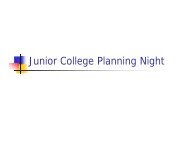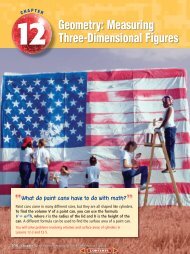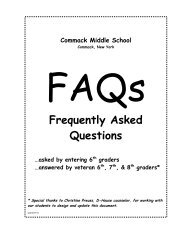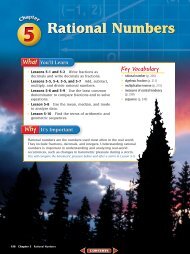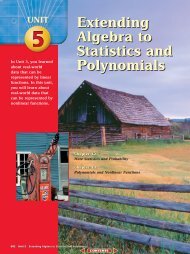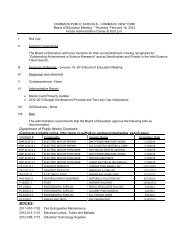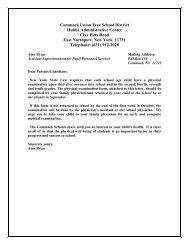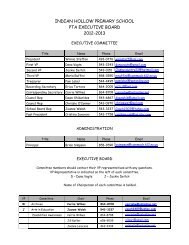Preparing for the Regents Examination Geometry, AK
Preparing for the Regents Examination Geometry, AK
Preparing for the Regents Examination Geometry, AK
Create successful ePaper yourself
Turn your PDF publications into a flip-book with our unique Google optimized e-Paper software.
31 a 20 √ 3 35<br />
b 20<br />
c 200 √ 3 346.4<br />
32 a AB BC 5 √ 2 . ABC is isosceles because<br />
<strong>the</strong>re is one pair of congruent sides.<br />
b Slope of −−<br />
AB 1. Slope of −−<br />
BC 1. Slopes<br />
are negative reciprocals, thus −−<br />
AB −−<br />
BC .<br />
c Area of ABC 25<br />
33 −−<br />
DE −−<br />
AV because <strong>the</strong> slope of −−<br />
DE slope<br />
of −−<br />
AV 1 _ .<br />
3 −−−<br />
DA is not parallel to −−<br />
VE because<br />
<strong>the</strong> slope of −−−<br />
DA is not equal to <strong>the</strong> slope<br />
of −−<br />
VE . DA VE 5; nonparallel sides are<br />
congruent. There<strong>for</strong>e, DAVE is an isosceles<br />
trapezoid.<br />
34 Slope of −−<br />
PQ slope of −−<br />
RS 3 _ . Slope of<br />
4 −−<br />
PS slope of −−−<br />
RQ 4 _ . Slope of<br />
3 −−<br />
PR 1 _ .<br />
7<br />
Slope of −−<br />
QS 7. PQRS is a parallelogram<br />
because opposite sides have <strong>the</strong> same slope,<br />
and a rhombus because <strong>the</strong> diagonals are<br />
perpendicular—slopes are negative reciprocals,<br />
and a square because consecutive sides<br />
are perpendicular—slopes are negative reciprocals.<br />
35 Slope of −−<br />
AB slope of −−−<br />
CD 0. Slope of<br />
−−<br />
BC slope of −−−<br />
AD 4 _ . Slope of<br />
3 −−<br />
AC 2.<br />
Slope of −−<br />
BD 1 _ . ABCD is a parallelogram<br />
2<br />
because opposite sides have <strong>the</strong> same slope,<br />
and a rhombus because <strong>the</strong> diagonals are<br />
perpendicular—slopes are negative<br />
reciprocals.<br />
36 Slope of −−<br />
LE slope of −−<br />
AF 4 _ . Slope<br />
5<br />
of −−<br />
EA slope of −−<br />
FL 4 _ . Slope of<br />
5 −−<br />
LA is<br />
udefined. Slope of −−<br />
EF 0. LEAF is a parallelogram<br />
because opposite sides have <strong>the</strong> same<br />
slope, and a rhombus because <strong>the</strong> diagonals<br />
are perpendicular.<br />
Note: Since <strong>the</strong>re are many variations of proofs,<br />
<strong>the</strong> following is simply one set of acceptable<br />
statements to complete each proof. Depending<br />
on <strong>the</strong> textbook used, <strong>the</strong> wording and <strong>for</strong>mat<br />
of reasons may differ, so <strong>the</strong>y have not been<br />
supplied <strong>for</strong> <strong>the</strong> method of congruence applied<br />
in each problem. (These solutions are intended<br />
to be used as a guide—o<strong>the</strong>r possible solutions<br />
may vary.)<br />
37 1. Quadrilateral TRIP<br />
2. −−<br />
TR −−<br />
RI<br />
3. m1 m2<br />
4. 1 2<br />
5. −−<br />
RA −−<br />
RA<br />
6. a RAT RAI (SAS SAS)<br />
7. −−<br />
TA −−<br />
AI (CPCTC)<br />
8. TAP IAP (Supplements of<br />
congruent angles<br />
are congruent.)<br />
9. −−<br />
AP −−<br />
AP<br />
10. TAP IAP (SAS SAS)<br />
11. b 3 4 (CPCTC)<br />
38 1. Parallelogram PQRS<br />
2. Diagonal −−<br />
QS bisects PQR.<br />
3. PQS RQS<br />
4. RQS QSP (Alternate interior<br />
angles are congruent.)<br />
5. PQS QSR (Alternate interior<br />
angles are congruent.)<br />
6. RQS QSR (Transitive postulate)<br />
7. QSP QSR<br />
8. −−<br />
PS −−<br />
PQ<br />
9. PS PQ<br />
10. PQRS is a rhombus. (A rhombus is a<br />
parallelogram with<br />
two congruent<br />
consecutive sides.)<br />
39 1. ABED is a rhombus.<br />
2. −−<br />
BD intersects −−−−<br />
AOEC at O.<br />
3. BOE and DOE are right angles.<br />
4. BOE and DOE are right triangles.<br />
5. −−<br />
OE −−<br />
OE<br />
6. −−<br />
BE −−<br />
DE<br />
7. BOE DOE (HL HL)<br />
8. −−<br />
BO −−−<br />
OD (CPCTC)<br />
9. BOC and DOC are right triangles.<br />
10. −−−<br />
OC −−−<br />
OC<br />
11. BOC DOC (Leg-leg)<br />
12. a −−<br />
BC −−−<br />
DC (CPCTC)<br />
13. −−<br />
AB −−−<br />
AD<br />
14. −−<br />
AC −−<br />
AC<br />
15. ABC ADC (SSS SSS)<br />
16. b ABC ADC (CPCTC)<br />
40 Mark <strong>the</strong> point of intersection of <strong>the</strong> diagonals<br />
E. The diagonals bisect each o<strong>the</strong>r,<br />
thus AE DE. By <strong>the</strong> triangle inequality<br />
<strong>the</strong>orem, mADE mDCE and<br />
mADC mDCB by <strong>the</strong> multiplication<br />
postulate of inequality.<br />
Chapter Review 67




